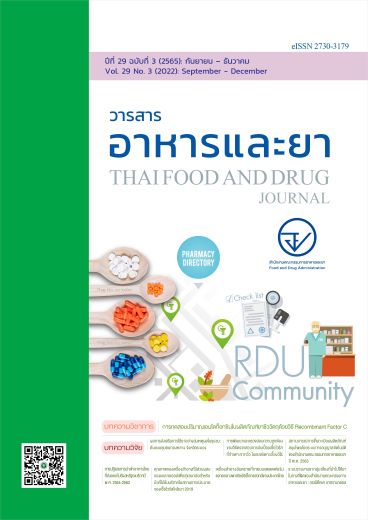การพัฒนาและตรวจสอบความถูกต้องของวิธีตรวจสอบการปนเปื้อนเชื้อไวรัสที่จำเพาะจากวัวในเซลล์เพาะเลี้ยงวีโร
Main Article Content
บทคัดย่อ
ความสำคัญ: เซลล์เพาะเลี้ยงที่ใช้ในการผลิตวัคซีนต้องควบคุมคุณภาพตามข้อกำหนดขององค์การอนามัยโลก การตรวจหาเชื้อไวรัสปนเปื้อนจากวัวในเซลล์ตั้งต้นเป็นหนึ่งในรายการทดสอบสำคัญ เพื่อยืนยันว่าเซลล์ที่ใช้ในการผลิตไม่มีการปนเปื้อนจากเชื้อไวรัสวัว โดยการศึกษานี้เป็นการเสริมสร้างศักยภาพห้องปฏิบัติการในการตรวจสอบคุณลักษณะและการควบคุมคุณภาพเซลล์ เพื่อให้สามารถนำมาถ่ายทอดไปยังผู้ผลิตวัคซีนภายในประเทศ และให้บริการตรวจสอบคุณภาพเซลล์วีโรที่ใช้ในการผลิตวัคซีน
วัตถุประสงค์: เพื่อศึกษาสภาวะที่เหมาะสม และตรวจสอบความถูกต้องของวิธีตรวจสอบการปนเปื้อนเชื้อไวรัสที่จำเพาะจากวัวในเซลล์เพาะเลี้ยงวีโร เพื่อใช้เป็นวิธีมาตรฐานทางห้องปฏิบัติการในการตรวจคุณภาพเซลล์เพาะเลี้ยงวีโรที่ใช้ในการผลิตวัคซีน
วิธีการวิจัย: เป็นการวิจัยเชิงทดลองโดยศึกษาสภาวะที่เหมาะสมของเทคนิคในการตรวจวิเคราะห์ 3 วิธี ได้แก่ การตรวจหาความผิดปกติของเซลลหลังการติดเชื้อ (Cytopathic Effect: CPE) การตรวจปฏิกิริยาการเกาะติดของเม็ดเลือดแดงบนผิวเซลล์ที่ติดเชื้อ (hemadsorption) และการทดสอบอิมมูโนฟลูออเรสเซนต์ (Immunofluorescent Assay: IFA) และตรวจสอบความถูกต้องของวิธีในพารามิเตอร์ หาความจำเพาะของวิธี และขีดจำกัดของการตรวจพบ
ผลการศึกษา: ผลการศึกษาสภาวะที่เหมาะสมพบว่าจำนวนเซลล์ Bovine Turbinate cells (BT), Madin-Darby bovine kidney cells (MDBK) และ African green monkey kidney cells (Vero) ที่เหมาะสมสำหรับการเกิด CPE ในเซลล์ คือ 1x105, 4x104 และ 4x104 cells/mL ตามลำดับ และผลการเกิด CPE มีความสอดคล้องกับการทดสอบ IFA ยกเว้นไวรัส REO-3 ที่ไม่พบ CPE ในเซลล์ BT แต่ตรวจพบไวรัสได้ด้วยวิธี IFA ในขณะที่การเกาะติดของเม็ดเลือดแดงนั้นพบเฉพาะในเซลล์ที่ติดเชื้อไวรัส BPI-3 และ BPV ผลการตรวจสอบความถูกต้องของวิธีที่พัฒนาขึ้น พบว่ามีความจำเพาะต่อเชื้อไวรัสวัวทั้ง 5 ชนิด และให้ค่าความแรงต่ำสุดที่ตรวจพบได้ 0.01, 0.1, 0.1, 0.01 และ 0.001 CCID50 /mL ตามลำดับ
สรุป: จากการศึกษาสภาวะที่เหมาะสม และตรวจสอบความถูกต้องของวิธีตรวจสอบการปนเปื้อนเชื้อไวรัสที่จำเพาะจากวัวในเซลล์เพาะเลี้ยงวีโร โดยใช้เทคนิคตรวจวิเคราะห์ 3 วิธี ได้แก่ การตรวจหาความผิดปกติของเซลลหลังการติดเชื้อ การเกิดปฏิกิริยาเกาะติดของเม็ดเลือดแดงบนผิวเซลล์ และการทดสอบแอนติบอดีที่จำเพาะกับเชื้อไวรัสด้วยเทคนิคอิมมูโนฟลูออเรสเซนต์ พบว่าวิธีทั้ง 3 สามารถตรวจสอบการปนเปื้อนเชื้อไวรัสที่จำเพาะจากวัวได้ และผลการทดสอบเป็นไปตามเกณฑ์ที่กำหนด จึงได้วิธีมาตรฐานทางห้องปฏิบัติการในการตรวจหาเชื้อไวรัสปนเปื้อนจากวัวในเซลล์เพาะเลี้ยงวีโร ซึ่งเป็นรายการทดสอบหนึ่งในการตรวจประเมินความปลอดภัยและความบริสุทธิ์ของเซลล์วีโรที่ใช้ในการผลิตวัคซีนได้
Article Details

อนุญาตภายใต้เงื่อนไข Creative Commons Attribution 4.0 International License.
เอกสารอ้างอิง
Kiesslich S, Kamen AA. Vero cell upstream bioprocess development for the production of viral vectors and vaccines. Biotech Adv. [Internet]. 2020 [Cited 2021 Dec 19]; 44; [9 screens]. Available from: https://doi.org/10.1016/j.biotechadv.2020.107608.
World Health Organization. Annex 3 recommendations for the evaluation of animal cell cultures as substrates for the manufacture of biological medicinal products and for the characterization of cell banks. TRS 978, Geneva; 2013 p. 123-65.
Food and Drug Administration. Guidance for industry characterization and qualification of cell substrates and other biological materials used in the production of viral vaccines for infectious disease indications [Internet]. Rockville; 2011 [cited 2020 Sep 9]; [50 screens]. Available from: https://www.fda.gov/media/78428/download
Gombold J, Karakasidis S, Niksa P, Podczasy J, Neumann K, Richardson J, et al. Systematic Evaluation of In Vitro and In Vivo adventitious virus assays for the detection of viral contamination of cell banks and biological products. Vaccine 2014; 32(24): 2916–26.
Marcus-Sekura C, Richardson JC, Harston RK, Sane N, Sheets RL. Evaluation of the human host range of bovine and porcine viruses that may contaminate bovine serum and porcine trypsin used in the manufacture of biological products. Biologicals 2011; 39: 359-69.
Nims RW. Detection of adventitious viruses in biologicals--a rare occurrence. Dev Biol (Basel) 2006; 123: 153-64.
World Health Organization. Annex 4 supplementary guidelines on good manufacturing practices: validation, appendix 4 analytical method validation. TRS 937, Geneva; 2006. p. 136-40.
International Conference on Harmonization (ICH). ICH Q2(R1) Validation of analytical
procedures: text and methodology [Internet]. 2005 [cited 2020 June 18]; [17 screens]. Available from: https://www.gmp-compliance.org/files/guidemgr/Q2(R1).pdf
European pharmacopoeia. 5.2.3 Cell substrates for the production of vaccines for human use. [Internet]. 2020 [cited 2020 November 21]; [4 screens]. Available from: https://www.edqm.eu/sites/default/files/medias/fichiers/COVID-19/updated_covid-19_vaccines_package_oct_2020.pdf
Landrya ML, Hsiungb GD. Diagnostic techniques: isolation and identification by culture and microscopy. In: Granoff A, Webster R, editors. Encyclopedia of virology. 2nd ed. London: Academic; 1999. p. 395-403.
MacLachlan NJ, Dubovi EJ. Chapter 3 pathogenesis of viral infections and diseases. In: Barthold SW, Swayne DE, Winton JR, editors. Fenner’s Veterinary Virology. 5th ed. London: Academic; 2017. p. 47-78.


